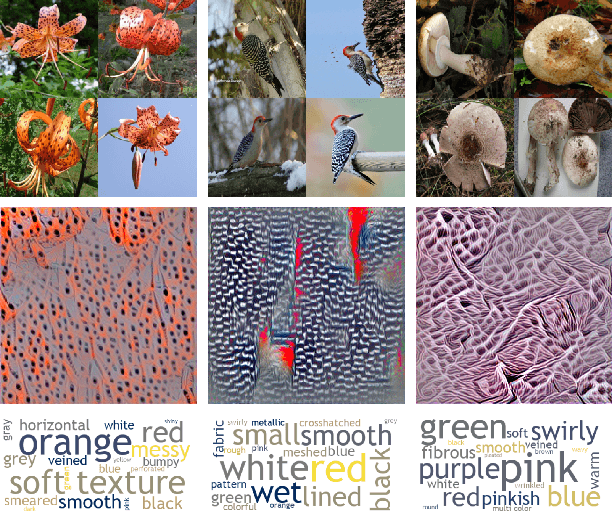Mikayla Timm
Describing Textures using Natural Language
Aug 03, 2020



Abstract:Textures in natural images can be characterized by color, shape, periodicity of elements within them, and other attributes that can be described using natural language. In this paper, we study the problem of describing visual attributes of texture on a novel dataset containing rich descriptions of textures, and conduct a systematic study of current generative and discriminative models for grounding language to images on this dataset. We find that while these models capture some properties of texture, they fail to capture several compositional properties, such as the colors of dots. We provide critical analysis of existing models by generating synthetic but realistic textures with different descriptions. Our dataset also allows us to train interpretable models and generate language-based explanations of what discriminative features are learned by deep networks for fine-grained categorization where texture plays a key role. We present visualizations of several fine-grained domains and show that texture attributes learned on our dataset offer improvements over expert-designed attributes on the Caltech-UCSD Birds dataset.
Visualizing and Describing Fine-grained Categories as Textures
Jul 02, 2019


Abstract:We analyze how categories from recent FGVC challenges can be described by their textural content. The motivation is that subtle differences between species of birds or butterflies can often be described in terms of the texture associated with them and that several top-performing networks are inspired by texture-based representations. These representations are characterized by orderless pooling of second-order filter activations such as in bilinear CNNs and the winner of the iNaturalist 2018 challenge. Concretely, for each category we (i) visualize the "maximal images" by obtaining inputs x that maximize the probability of the particular class according to a texture-based deep network, and (ii) automatically describe the maximal images using a set of texture attributes. The models for texture captioning were trained on our ongoing efforts on collecting a dataset of describable textures building on the DTD dataset. These visualizations indicate what aspects of the texture is most discriminative for each category while the descriptions provide a language-based explanation of the same.
 Add to Chrome
Add to Chrome Add to Firefox
Add to Firefox Add to Edge
Add to Edge